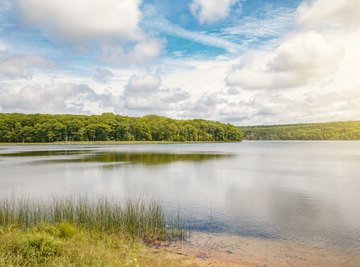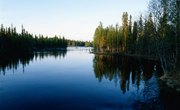
Believe it or not, there is water below your feet. Even if the ground you stand on is dry, if you dig deep enough, you are likely to discover groundwater. Surface water, like lakes and rivers, might be all the water you can see, but groundwater is one of the most important water resources on the planet. That groundwater can be found in one of two places: aquifers and the water table. What is the difference between the water table and an aquifer?
Water Table vs. Aquifer
Imagine the ground below you as a cake with layers. Everything on top, including trees and buildings, is the icing. The icing sits directly on top of the soil layer. The layer below that is rock.
As water falls on the surface of the Earth, most of it flows into streams. Some of that water percolates into soil. As gravity pulls the water deeper into the soil layer, it tends to pool on top of the bedrock. The soil immediately above the bedrock is fully saturated with water, while the soil just beneath the surface is unsaturated. The line between saturated soil and unsaturated soil is known as the water table. The water below the water table makes up an unconfined aquifer.
Below the unconfined aquifer, you can find confined aquifers. Confined aquifers are reservoirs of water that managed to seep below the confining rock layer, and they are separated from unconfined aquifers typically by a relatively impermeable layer of either rock or clay.
Little by little, groundwater from the soil can fill the hollow spaces within the rock layer. The difference between the water table and an aquifer is that the water table refers to the level of the unconfined aquifer, and the aquifer is an underground reservoir.
Where Is the Water Table?
Because the water table relies on percolation from the surface, the water table is almost never static. It moves up as more water is added to it, either through rainfall, snowmelt or crop irrigation. However, just like it moves up, it also moves down as groundwater in the unconfined aquifer is depleted. This happens when humans draw water from wells, which are pits that extend from the surface to below the water table, allowing water to be pulled or pumped to the surface.
Because the water below the water table is completely absorbed into soil, the water table is not flat. Instead, the water table follows geography. It is higher in some places and lower in others.
You can see the water table without having to dig a well, because sometimes the water table intersects the surface of the ground. In other words, the ground dips below the water table in some places - you know these locations as lakes.
By observing the lake, it is possible to track the movement of the water table. As the water table drops due to depletion, so does the lake's surface. There is no difference between the terms water table and water level - they are two ways of referring to the same thing.
What Are Confined Aquifers?
Confined aquifers are giant reservoirs of water embedded within rock far below the surface. Instead of being massive underground lakes, these are bodies of water that can freely move through cracks and crevices within the rock.
Confined aquifers are connected to the unconfined aquifers in that water from the water table can seep into the confined aquifer. This process, though, happens very slowly. While the unconfined aquifer above rises and falls with rainfall, the confined aquifer below will take on water at a fixed rate.
This is a problem because, in much of the world, people are draining aquifers faster than they can be replenished. Deep wells that can access confined aquifers are often used to irrigate crops, and so they draw a lot of water from the aquifer. This is called aquifer depletion, and it has negative implications for water availability in the future, although in some areas, sustainable water use practices have been able to prevent aquifer depletion.
References
About the Author
Cameron is a writer and educator based out of Fort Collins, Colorado. His work has appeared in New Scientist, LiveScience, Discovery's Curiosity Daily podcast, and MinuteEarth. He teaches Ecology and Evolution at the University of Northern Colorado.
